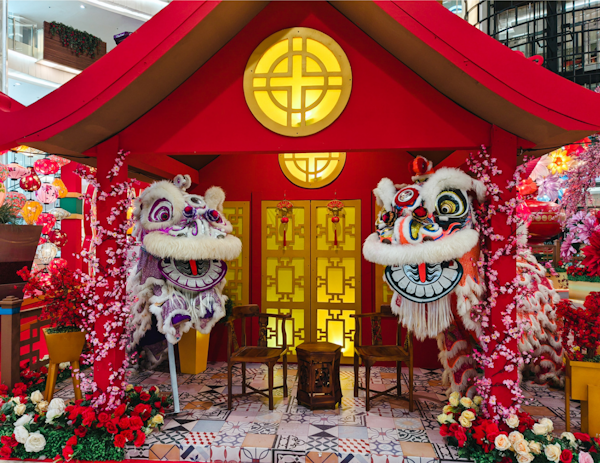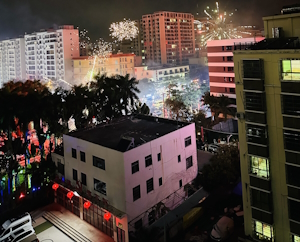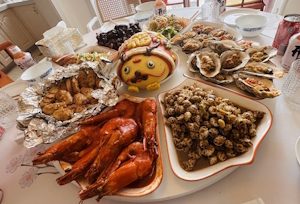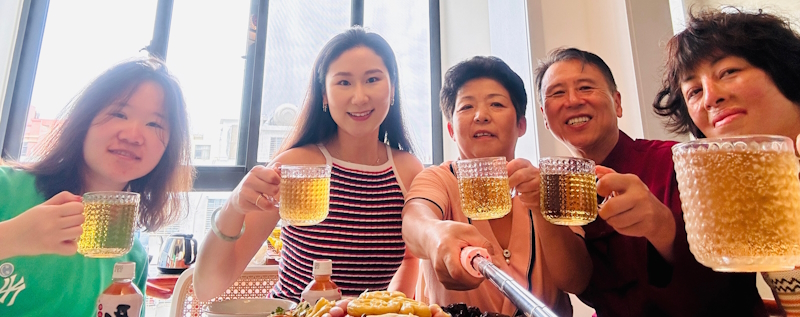 |
January 1st has come and gone, but you don’t need to wait a full year before celebrating again. Don your red socks and new clothes — Lunar New Year begins February 10, 2024! by Anna Hartman |
What is Chinese Lunar New Year?
The holiday of Lunar New Year is thousands of years old and begins on the first new moon of the Lunar Calendar. The weeks-long celebration ends on the first full moon of the lunisolar calendar. As it is based on the cycles of the moon, the holiday does not have a set date, but based on the globally recognized Gregorian calendar occurs between late January and early February.
The most well known Lunar New Year celebration occurs in China and thus many refer to the holiday as Chinese New Year. However, countries across Asia celebrate the fifteen days, which is also known as Spring Festival as it marks the onset of the lunar calendar spring.
A Time to Celebrate!

Lunar New Year is full of lore, including the legend of Nian, a ghastly beast that came out on New Year’s day and feasted on human flesh. Nian was afraid of the color red, loud noises, and fires, so to keep Nian at bay, families would decorate the home in red and light lanterns and set off loud fireworks. These traditions continue to this day with the holiday being connected to the lucky color red and light.
In China, every year is associated with a Chinese zodiac symbol. Unlike in the West, it is years, not months that correspond to zodiac symbols. It is believed that people born in the same year share certain personal characteristics. This year is the year of the dragon. Dragons in Chinese culture symbolize great power, good luck, and strength.
Lunar New Year is a time for fresh starts and new beginnings. Houses are cleaned leading up to the new year in a tradition called “sweeping the grounds” to remove any bad luck that may be lingering.
Across Asia families come together to celebrate the new year with regional and familial traditions. While the red envelope full of money is established around the world, other customs are less commonly known. Shenrui, a Worldview Project volunteer who hails from Harbin, shared how her family (and many across China) celebrates Chinese Lunar New Year.
To ring in the new year, everyone wears new clothing (even undergarments). And if you are lucky enough to be born in the year’s Chinese zodiac animal, you must wear red. This year that means, all dragons will wear red for new years and beyond.
Red socks with the image of a person on the sole are worn by all of Shenrui's family. As the clock strikes the new year, everyone steps down and squishes the “person” as a symbol of those who wish to sabotage you.

On New Year’s Eve, Shenrui’s family make dumplings in preparation for a large feast. A coin is hidden in several dumplings and the lucky ones to find a coin, are promised prosperity in the coming year.
During New Year's Eve, the nation watches “Chunwan”, the CCTV New Year's Gala. Chunwan is a variety show that lasts over four hours and features comedians, singers, dancers, acrobats, and other engaging performers. In 2012, the “Guiness Book of World Records” recognized Chunwan as the “Most Watched National Network TV Broadcast” in the world.
Over the years, Chunwan has evolved to include new technologies. Viewers can call in to request songs or enter lotteries by shaking their phone. Shenrui says, “Even my grandmother shakes her phone.”
As the festive week continues, cleaning and food preparation are suspended until the fifth day of the new year. Other notable days include the third day when it is traditional to visit the graves of late relatives to pay respects. The seventh day, known as Renri, is honored as the universal birthday of man.
The Fifteenth Day: Lantern Festival
The Lantern Festival, which occurs on the first full moon of the lunar calendar, marks the end of Lunar New Year. A time of peace and forgiveness, the fifteenth day honors deceased ancestors. Red paper lanterns are lit and released into the air as a liberation of the old and a commitment to the new.
Houses are decorated with colorful lanterns, families attend parades with lion and dragon dancers, and fireworks are set off. This celebration is thought to have its origins in the Han dynasty (206 BC to 220 AD) when Buddhist monks would light lanterns in honor of Buddha. These traditions later spread throughout China and the rest of Asia.
Lunar New Year is a time of hope—a time to let go of the past and embrace the new. So, let go of last year and welcome the new year. Here is to a year full of prosperity and good luck.
And as the Chinese say, Xin nian kuai le! (Happy New Year in Mandarin.)

Some Local Lunar New Year Events
San Diego Lunar New Year Festival is a 3-day celebration featuring dazzling lanterns, folk and traditional performances, arts and cultural exhibitions, lion dances and firecrackers, and plenty of family fun activities for the kids.
Friday, February, 9 - 5:00 PM to 10:00 PM, Saturday, February 10, 11:00 AM to 10:00 PM, Sunday, February 11, 11:00 AM to 8:00 PM
City Heights Performance Annex
4455 Wightman St., San Diego
Celebrating Year of the Dragon with crafts, performances by Grace Academy, and the Lion dance by San Diego Lucky Lion Dancers.
Tuesday, February, 13 - 5:00 PM to 7:00 PM
4S Ranch Library
10433 Reserve Drive, San Diego
San Diego Tết Festival.. The largest Vietnamese New Year event in San Diego with lion dancing, Taiko drums, carnival rides and more. Nominal fee for rides
Friday through Sunday, February 16 to 18 at Miramesa Park.
8575 New Salem St., San Diego
Balboa Park Chinese New Year Festival. Lion dances, ethnic food, cultural performances, crafts and more.
Saturday and Sunday, February 17 and 18, 11:00 AM to 5:00 PM at the International Cottages
Balboa Park, San Diego
Celebrate the Year of the Dragon! With a Photobooth, Crafts, and Cultural Performances featuring Lion Dancers at 3:00 PM
Sunday, February 18 - 2:00 PM to 4:00 PM at the Poway Library
13137 Poway Road, Poway
More events can be found on the San Diego Participant Observer Calendar









